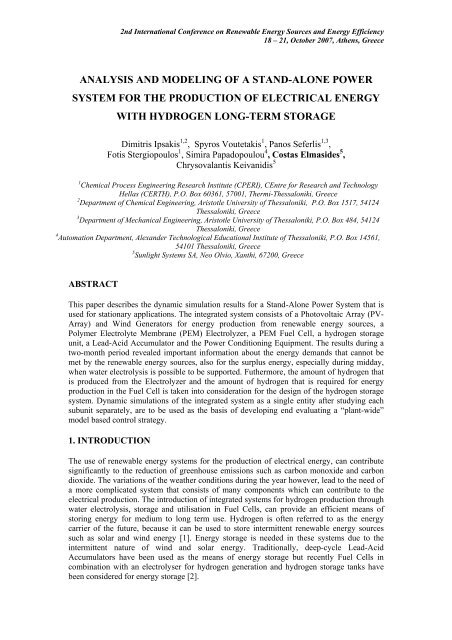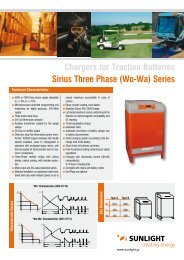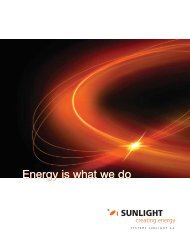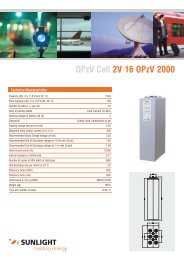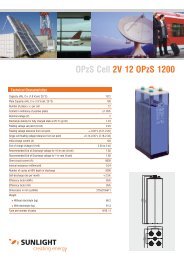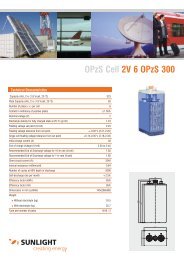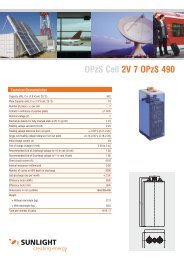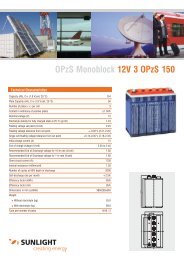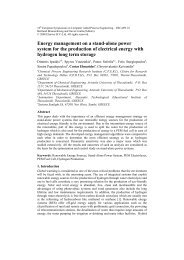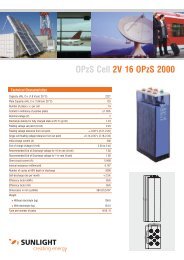analysis and modeling of a stand-alone power system for the ...
analysis and modeling of a stand-alone power system for the ...
analysis and modeling of a stand-alone power system for the ...
Create successful ePaper yourself
Turn your PDF publications into a flip-book with our unique Google optimized e-Paper software.
2nd International Conference on Renewable Energy Sources <strong>and</strong> Energy Efficiency<br />
18 – 21, October 2007, A<strong>the</strong>ns, Greece<br />
ANALYSIS AND MODELING OF A STAND-ALONE POWER<br />
SYSTEM FOR THE PRODUCTION OF ELECTRICAL ENERGY<br />
WITH HYDROGEN LONG-TERM STORAGE<br />
Dimitris Ipsakis 1,2 , Spyros Voutetakis 1 , Panos Seferlis 1,3 ,<br />
Fotis Stergiopoulos 1 , Simira Papadopoulou 4 , Costas Elmasides 5 ,<br />
Chrysovalantis Keivanidis 5<br />
1 Chemical Process Engineering Research Institute (CPERI), CEntre <strong>for</strong> Research <strong>and</strong> Technology<br />
Hellas (CERTH), P.O. Box 60361, 57001, Thermi-Thessaloniki, Greece<br />
2 Department <strong>of</strong> Chemical Engineering, Aristotle University <strong>of</strong> Thessaloniki, P.O. Box 1517, 54124<br />
Thessaloniki, Greece<br />
3 Department <strong>of</strong> Mechanical Engineering, Aristotle University <strong>of</strong> Thessaloniki, P.O. Box 484, 54124<br />
Thessaloniki, Greece<br />
4 Automation Department, Alex<strong>and</strong>er Technological Educational Institute <strong>of</strong> Thessaloniki, P.O. Box 14561,<br />
54101 Thessaloniki, Greece<br />
5 Sunlight Systems SA, Neo Olvio, Xanthi, 67200, Greece<br />
ABSTRACT<br />
This paper describes <strong>the</strong> dynamic simulation results <strong>for</strong> a St<strong>and</strong>-Alone Power System that is<br />
used <strong>for</strong> stationary applications. The integrated <strong>system</strong> consists <strong>of</strong> a Photovoltaic Array (PV-<br />
Array) <strong>and</strong> Wind Generators <strong>for</strong> energy production from renewable energy sources, a<br />
Polymer Electrolyte Membrane (PEM) Electrolyzer, a PEM Fuel Cell, a hydrogen storage<br />
unit, a Lead-Acid Accumulator <strong>and</strong> <strong>the</strong> Power Conditioning Equipment. The results during a<br />
two-month period revealed important in<strong>for</strong>mation about <strong>the</strong> energy dem<strong>and</strong>s that cannot be<br />
met by <strong>the</strong> renewable energy sources, also <strong>for</strong> <strong>the</strong> surplus energy, especially during midday,<br />
when water electrolysis is possible to be supported. Fu<strong>the</strong>rmore, <strong>the</strong> amount <strong>of</strong> hydrogen that<br />
is produced from <strong>the</strong> Electrolyzer <strong>and</strong> <strong>the</strong> amount <strong>of</strong> hydrogen that is required <strong>for</strong> energy<br />
production in <strong>the</strong> Fuel Cell is taken into consideration <strong>for</strong> <strong>the</strong> design <strong>of</strong> <strong>the</strong> hydrogen storage<br />
<strong>system</strong>. Dynamic simulations <strong>of</strong> <strong>the</strong> integrated <strong>system</strong> as a single entity after studying each<br />
subunit separately, are to be used as <strong>the</strong> basis <strong>of</strong> developing end evaluating a “plant-wide”<br />
model based control strategy.<br />
1. INTRODUCTION<br />
The use <strong>of</strong> renewable energy <strong>system</strong>s <strong>for</strong> <strong>the</strong> production <strong>of</strong> electrical energy, can contribute<br />
significantly to <strong>the</strong> reduction <strong>of</strong> greenhouse emissions such as carbon monoxide <strong>and</strong> carbon<br />
dioxide. The variations <strong>of</strong> <strong>the</strong> wea<strong>the</strong>r conditions during <strong>the</strong> year however, lead to <strong>the</strong> need <strong>of</strong><br />
a more complicated <strong>system</strong> that consists <strong>of</strong> many components which can contribute to <strong>the</strong><br />
electrical production. The introduction <strong>of</strong> integrated <strong>system</strong>s <strong>for</strong> hydrogen production through<br />
water electrolysis, storage <strong>and</strong> utilisation in Fuel Cells, can provide an efficient means <strong>of</strong><br />
storing energy <strong>for</strong> medium to long term use. Hydrogen is <strong>of</strong>ten referred to as <strong>the</strong> energy<br />
carrier <strong>of</strong> <strong>the</strong> future, because it can be used to store intermittent renewable energy sources<br />
such as solar <strong>and</strong> wind energy [1]. Energy storage is needed in <strong>the</strong>se <strong>system</strong>s due to <strong>the</strong><br />
intermittent nature <strong>of</strong> wind <strong>and</strong> solar energy. Traditionally, deep-cycle Lead-Acid<br />
Accumulators have been used as <strong>the</strong> means <strong>of</strong> energy storage but recently Fuel Cells in<br />
combination with an electrolyser <strong>for</strong> hydrogen generation <strong>and</strong> hydrogen storage tanks have<br />
been considered <strong>for</strong> energy storage [2].
2nd International Conference on Renewable Energy Sources <strong>and</strong> Energy Efficiency<br />
18 – 21, October 2007, A<strong>the</strong>ns, Greece<br />
The advantages <strong>of</strong> using PV-<strong>system</strong>s <strong>and</strong> Wind Generators to generate electricity<br />
include <strong>the</strong> avoidance <strong>of</strong> pollutants emissions, long lifetime <strong>and</strong> low maintenance requirement<br />
[2]. Moreover, solar <strong>and</strong> wind energy is abundant, free, clean <strong>and</strong> inexhaustible.<br />
Previous studies on <strong>modeling</strong> <strong>of</strong> St<strong>and</strong>-Alone Power Systems considered each<br />
sub<strong>system</strong> as individual. Ulleberg Ø. [3], introduced <strong>and</strong> evaluated various models <strong>for</strong> each<br />
sub<strong>system</strong> whereas <strong>the</strong> Wind Generator wasn’t included in <strong>the</strong> original scheme. The results<br />
were very close to <strong>the</strong> experimental data from <strong>the</strong> implementation. Kohle et al. [4], presented<br />
a model <strong>for</strong> a PV-Array coupled with a Wind Generator that takes into account<br />
meteorological data <strong>and</strong> gives a daily pr<strong>of</strong>ile <strong>of</strong> <strong>the</strong> produced energy. A dynamic model <strong>of</strong> a<br />
PEM Electrolyzer was introduced <strong>and</strong> evaluated by Gorgun [5], whereas <strong>the</strong> simulated results<br />
<strong>for</strong> <strong>the</strong> hydrogen production were used <strong>for</strong> <strong>the</strong> study <strong>of</strong> <strong>the</strong> storage dynamics. The Fuel Cell<br />
characteristics were studied extensively where among o<strong>the</strong>rs <strong>the</strong> electrical behaviour was<br />
described by empirical equations [6] <strong>and</strong> <strong>the</strong> dynamic behaviour was described by a set <strong>of</strong><br />
differential equations [7]. Fur<strong>the</strong>rmore, Manwell J.F. <strong>and</strong> McGowan J.G. [8] developed <strong>the</strong><br />
KiBaM model that is used <strong>for</strong> <strong>modeling</strong> Lead-Acid Accumulators. Their model is very<br />
accurate <strong>for</strong> different types <strong>of</strong> Accumulators as it only requires three parameters that can be<br />
found by manufactures’ data. Moreover, o<strong>the</strong>r studies regarded <strong>the</strong> experience gained from<br />
<strong>the</strong> operation <strong>of</strong> such an integrated <strong>system</strong> [9, 10].<br />
In this study, <strong>the</strong> simulated results <strong>for</strong> each sub<strong>system</strong> <strong>of</strong> <strong>the</strong> St<strong>and</strong>-Alone Power<br />
System during a two-month period will be presented. Applications scenarios were examined<br />
in order to study <strong>the</strong> behaviour <strong>of</strong> <strong>the</strong> Lead-Acid Accumulator during <strong>the</strong> two months where<br />
constant charges <strong>and</strong> discharges took place. Moreover, <strong>the</strong> amount <strong>of</strong> hydrogen that was<br />
produced through water electrolysis was used <strong>for</strong> <strong>the</strong> study <strong>of</strong> <strong>the</strong> storage capacity in relation<br />
with <strong>the</strong> amount <strong>of</strong> hydrogen that was required <strong>and</strong> consumed in <strong>the</strong> Fuel Cell unit.<br />
2. Integrated System <strong>for</strong> <strong>the</strong> Production <strong>of</strong> Electrical Energy<br />
An application utilizing solar <strong>and</strong> wind energy with hydrogen production through water<br />
electrolysis, storage <strong>and</strong> utilisation in Fuel Cells is currently under development at Neo Olvio,<br />
Xanthi in <strong>the</strong> framework <strong>of</strong> a research project with <strong>the</strong> participation <strong>of</strong> Chemical Process<br />
Engineering Research Institute <strong>and</strong> Sunlight Systems S.A. The Renewable Energy System<br />
consists <strong>of</strong> a PV-Array with an installed capacity <strong>of</strong> 5 kW p <strong>and</strong> three (3) Wind Generators<br />
rated at 3kW p totally. Surplus energy is to be supplied to a PEM Electrolyzer, rated at 4.2kW p<br />
after <strong>the</strong> dem<strong>and</strong>s <strong>for</strong> a 1kW constant load have been met. The hydrogen produced is to be<br />
stored in cylinders under high pressure. In case <strong>the</strong>re is a lack <strong>of</strong> energy, a PEM Fuel Cell<br />
rated at 4kW p is going to be used to provide <strong>power</strong>. Also, in order to account <strong>for</strong> short-term<br />
dem<strong>and</strong>s, a Lead-Acid Accumulator with a total capacity <strong>of</strong> 3000Ah, 48V is also used <strong>and</strong><br />
charged by <strong>the</strong> renewable energy sources or <strong>the</strong> Fuel Cell depending on <strong>the</strong> availability <strong>of</strong> <strong>the</strong><br />
renewable energy sources. A back up unit (Diesel Generator) could be used in order to cover<br />
<strong>the</strong> electrical needs that can’t be met by <strong>the</strong> <strong>system</strong>. Its potential use however, would be<br />
identified during <strong>the</strong> study <strong>of</strong> <strong>the</strong> <strong>system</strong>. Fur<strong>the</strong>rmore, <strong>power</strong> electronic converters are<br />
employed <strong>for</strong> <strong>power</strong> management <strong>and</strong> <strong>for</strong> <strong>the</strong> integration <strong>of</strong> <strong>the</strong> various sub<strong>system</strong>s. Figure 1<br />
represents a layout <strong>of</strong> <strong>the</strong> <strong>system</strong> developed.
2nd International Conference on Renewable Energy Sources <strong>and</strong> Energy Efficiency<br />
18 – 21, October 2007, A<strong>the</strong>ns, Greece<br />
Figure 1: Block diagram <strong>of</strong> <strong>the</strong> proposed St<strong>and</strong>-Alone Power System<br />
3. Simulation <strong>of</strong> <strong>the</strong> Integrated System During a Two-Month Period<br />
The design <strong>and</strong> <strong>analysis</strong> <strong>of</strong> <strong>the</strong> a<strong>for</strong>ementioned integrated <strong>system</strong> requires detailed<br />
ma<strong>the</strong>matical models <strong>for</strong> <strong>the</strong> various sub<strong>system</strong>s in order to evaluate <strong>the</strong> per<strong>for</strong>mance <strong>of</strong> each<br />
unit separately be<strong>for</strong>e studying <strong>the</strong> St<strong>and</strong>-Alone Power System as a single entity. Initially,<br />
each sub<strong>system</strong> was modeled individually be<strong>for</strong>e integrating all <strong>the</strong> components in <strong>the</strong><br />
simulation model. Matlab ® was used as <strong>the</strong> simulation tool <strong>for</strong> <strong>the</strong> study <strong>of</strong> <strong>the</strong> integrated<br />
<strong>system</strong>. In this paragraph, <strong>the</strong> simulated results from <strong>the</strong> operation <strong>of</strong> <strong>the</strong> integrated St<strong>and</strong>-<br />
Alone Power System will be presented <strong>and</strong> discussed. The basic steps <strong>of</strong> <strong>the</strong> study are <strong>the</strong><br />
following:<br />
• Calculation <strong>of</strong> <strong>the</strong> output <strong>power</strong> from <strong>the</strong> PV-array <strong>and</strong> <strong>the</strong> Wind Generators <strong>for</strong><br />
time period equal to two (2) months.<br />
• Calculation <strong>of</strong> <strong>the</strong> charging current, discharging current <strong>and</strong> State-<strong>of</strong>-Charge<br />
(SOC) <strong>for</strong> <strong>the</strong> Lead-Acid Accumulator based on <strong>the</strong> developed algorithm.<br />
• Calculation <strong>of</strong> <strong>the</strong> total hydrogen production <strong>and</strong> consumption during <strong>the</strong> two<br />
month period.<br />
• Study <strong>of</strong> various scenarios regarding <strong>the</strong> SOC <strong>of</strong> <strong>the</strong> Accumulator <strong>and</strong> <strong>the</strong> output<br />
<strong>power</strong> from <strong>the</strong> Fuel Cell.<br />
The results from <strong>the</strong> auxiliary units such as <strong>the</strong> compressor <strong>and</strong> <strong>the</strong> buffer tanks are not<br />
presented in this study.<br />
3.1 Renewable Energy System<br />
The Renewable Energy System (RES) comprises <strong>the</strong> PV-Array <strong>and</strong> <strong>the</strong> Wind Generators.<br />
Solar radiation, wind speed <strong>and</strong> temperature as a function <strong>of</strong> time are used as input data in<br />
order to calculate <strong>the</strong> output <strong>power</strong> from <strong>the</strong> PV-array <strong>and</strong> <strong>the</strong> Wind Generators.<br />
The relationship that describes <strong>the</strong> Current-Voltage (I-V) characteristics in a PV-System was<br />
based on an equivalent electrical circuit that depicts <strong>the</strong> electrical phenomena during <strong>the</strong> solar<br />
absorption from <strong>the</strong> module. This relationship is given by Eq.(1), [3]:
2nd International Conference on Renewable Energy Sources <strong>and</strong> Energy Efficiency<br />
18 – 21, October 2007, A<strong>the</strong>ns, Greece<br />
V<br />
pv<br />
+ I<br />
pv<br />
⋅ Rs<br />
I<br />
pv<br />
= I<br />
L<br />
− I<br />
D<br />
− I<br />
sh<br />
= I<br />
L<br />
− I<br />
O<br />
⋅[exp(<br />
) −1]<br />
(1)<br />
α<br />
where I pv , I L , I D , I sh denote <strong>the</strong> operation current, light current, diode current <strong>and</strong> shunt current<br />
respectively in A, I o <strong>the</strong> diode reverse saturation current in A, R s <strong>the</strong> series resistance in Ω, α<br />
<strong>the</strong> curve fitting parameter in Volt <strong>and</strong> V pv <strong>the</strong> operation voltage in Volt<br />
The above parameters depend on <strong>the</strong> solar radiation <strong>and</strong> <strong>the</strong> cell temperature <strong>and</strong> can be easily<br />
calculated from manufacturer’s data which are provided <strong>for</strong> <strong>the</strong> PV-modules. The <strong>power</strong> from<br />
<strong>the</strong> PV-Array is described as known from:<br />
P<br />
= V pv<br />
⋅ I<br />
⋅η<br />
pv pv conv<br />
(2)<br />
where η conv denotes <strong>the</strong> efficiency <strong>of</strong> <strong>the</strong> DC/DC converter~90-95%<br />
The output <strong>power</strong> <strong>of</strong> <strong>the</strong> Wind Generator is given by <strong>the</strong> following equation [11]:<br />
P<br />
m<br />
= c<br />
ρ ⋅ Α<br />
w 3<br />
p<br />
( λ,<br />
β ) ⋅ vwind<br />
⋅ηinv<br />
(3)<br />
2<br />
where P m denotes <strong>the</strong> mechanical output <strong>of</strong> <strong>the</strong> turbine in W, c p <strong>the</strong> per<strong>for</strong>mance coefficient <strong>of</strong><br />
<strong>the</strong> turbine, ρ <strong>the</strong> air density in kg/m 3 , Α w <strong>the</strong> turbine swept area in m 2 , v wind <strong>the</strong> wind speed in<br />
m/s, λ <strong>the</strong> tip speed ratio, β <strong>the</strong> blade pitch angle in deg <strong>and</strong> η inv denotes <strong>the</strong> efficiency <strong>of</strong> <strong>the</strong><br />
AC/DC converter~90-95%<br />
The relationship <strong>for</strong> c p is given by equation that is based on <strong>the</strong> characteristics <strong>of</strong> <strong>the</strong> wind<br />
turbine <strong>and</strong> can also be estimated from manufacturer’s data regarding <strong>the</strong> rotor speed in<br />
relation with <strong>the</strong> wind speed [10]. From <strong>the</strong> above equations <strong>the</strong> <strong>power</strong> from <strong>the</strong> PV-Array<br />
<strong>and</strong> <strong>the</strong> Wind Generators is presented in figures 2 <strong>and</strong> 3 respectively.<br />
5000<br />
1800<br />
Output Power, Watt<br />
4000<br />
3000<br />
2000<br />
1000<br />
Output Power, Watt<br />
1600<br />
1400<br />
1200<br />
1000<br />
800<br />
600<br />
400<br />
200<br />
0<br />
0 200 400 600 800 1000 1200 1400<br />
Time, h<br />
0<br />
0 200 400 600 800 1000 1200 1400<br />
Time, h<br />
Figure 2: Output Power from <strong>the</strong> 5kW p Photovoltaic<br />
System<br />
Figure 3: Output Power from <strong>the</strong> 3kW p Wind<br />
Generators<br />
3.2 Lead-Acid Accumulator<br />
The total <strong>power</strong>, P RES is calculated by <strong>the</strong> sum <strong>of</strong> <strong>the</strong> <strong>power</strong> P pv <strong>and</strong> P m . The <strong>power</strong> dem<strong>and</strong><br />
<strong>for</strong> <strong>the</strong> Load, P load is constant throughout <strong>the</strong> year at 1kW (or <strong>the</strong> equivalent energy is<br />
24kWh/day). The shortage or surplus <strong>power</strong> is calculated as:
2nd International Conference on Renewable Energy Sources <strong>and</strong> Energy Efficiency<br />
18 – 21, October 2007, A<strong>the</strong>ns, Greece<br />
P = P RES<br />
− P load<br />
(4)<br />
Based, on <strong>the</strong> deficit or shortage <strong>of</strong> <strong>power</strong> an Energy Management (EM) strategy was<br />
developed <strong>and</strong> used.<br />
Two limits <strong>of</strong> <strong>the</strong> State-<strong>of</strong>-Charge <strong>of</strong> <strong>the</strong> Accumulator are introduced: <strong>the</strong> minimum State-<strong>of</strong>-<br />
Charge, SOC min , where <strong>power</strong> needs to be provided to <strong>the</strong> Accumulator <strong>and</strong> <strong>the</strong> maximum<br />
State-<strong>of</strong>-Charge, SOC max , where <strong>the</strong> Electrolyzer is possible to operate. The basic steps <strong>of</strong> <strong>the</strong><br />
EM-algortihm are explained below.<br />
• If P0 <strong>the</strong>n <strong>the</strong> surplus <strong>power</strong> is provided to <strong>the</strong> Electrolyzer <strong>for</strong> <strong>the</strong> production <strong>of</strong><br />
hydrogen or to charge <strong>the</strong> Accumulator, depending on <strong>the</strong> SOC: if SOC≥SOC max <strong>the</strong>n<br />
<strong>the</strong> surplus energy is provided to <strong>the</strong> Electrolyzer as long as P≥P min,elec . If P≤ P min,elec<br />
or if P≥ P max,elec <strong>the</strong>n <strong>the</strong> spared energy is used to charge <strong>the</strong> battery.<br />
Figure 4 presents <strong>the</strong> operation current <strong>of</strong> <strong>the</strong> Accumulator that has been calculated according<br />
to <strong>the</strong> EM-algorithm. The negative values indicate <strong>the</strong> charging that takes place while positive<br />
values imply <strong>the</strong> discharging due to lack <strong>of</strong> <strong>power</strong>. A very important parameter that needed to<br />
be studied in detail was <strong>the</strong> SOC as it influences <strong>the</strong> operation <strong>of</strong> <strong>the</strong> Accumulator, <strong>of</strong> <strong>the</strong><br />
Electrolyzer <strong>and</strong> <strong>of</strong> <strong>the</strong> Fuel Cell. The SOC max limit was assumed to be 91% <strong>and</strong> <strong>the</strong> SOC min<br />
limit was assumed to be 84%. The State-<strong>of</strong>-Charge <strong>of</strong> <strong>the</strong> Accumulator is given by:<br />
SOC( t + 1) = SOC(<br />
t)<br />
⋅σ + I ⋅η<br />
⋅ ( ∆t)<br />
(5)<br />
ac<br />
ac<br />
ac<br />
where SOC is <strong>the</strong> State-<strong>of</strong>-Charge <strong>of</strong> <strong>the</strong> Accumulator in %, η ac is <strong>the</strong> efficiency factor ~95%,<br />
Ι ac is <strong>the</strong> charging/discharging current in Α, σ ac is <strong>the</strong> discharging rate <strong>of</strong> <strong>the</strong> Accumulator <strong>and</strong><br />
t is <strong>the</strong> time in hr.<br />
30<br />
100<br />
Current, A<br />
15<br />
0<br />
-15<br />
-30<br />
-45<br />
-60<br />
State <strong>of</strong> Charge, %<br />
98<br />
96<br />
94<br />
92<br />
90<br />
88<br />
86<br />
SOCmax<br />
-75<br />
84<br />
SOCmin<br />
-90<br />
0 200 400 600 800 1000 1200 1400<br />
Time, h<br />
82<br />
0 200 400 600 800 1000 1200 1400<br />
Time, h<br />
Figure 4: Operation Current during <strong>the</strong> twomonth<br />
period<br />
Figure 5: State <strong>of</strong> Charge <strong>of</strong> <strong>the</strong><br />
Accumulator during <strong>the</strong> two-month period
3.3 Hydrogen Unit<br />
2nd International Conference on Renewable Energy Sources <strong>and</strong> Energy Efficiency<br />
18 – 21, October 2007, A<strong>the</strong>ns, Greece<br />
As was mentioned earlier, <strong>the</strong> electrolysis took place only when sufficient surplus energy<br />
existed from <strong>the</strong> Renewable Energy System <strong>and</strong> <strong>the</strong> SOC <strong>of</strong> <strong>the</strong> Accumulator was above <strong>the</strong><br />
upper limit. Similarly, <strong>the</strong> Fuel Cell operated when <strong>the</strong>re was lack <strong>of</strong> energy <strong>and</strong> <strong>the</strong> SOC <strong>of</strong><br />
<strong>the</strong> Accumulator reached <strong>the</strong> lower limit. In both cases, <strong>the</strong> hydrogen that was produced from<br />
<strong>the</strong> excess energy at <strong>the</strong> PEM Electrolyzer <strong>and</strong> <strong>the</strong> hydrogen consumed at <strong>the</strong> PEM Fuel Cell<br />
is given by Eq. (6).<br />
n<br />
H 2<br />
=<br />
n<br />
c<br />
⋅ I<br />
n ⋅ F<br />
⋅ n<br />
F<br />
(6)<br />
where n H2 denotes <strong>the</strong> hydrogen flow rate in mol s -1 , n c <strong>the</strong> number <strong>of</strong> cells (Electrolyzer or<br />
Fuel Cell), n <strong>the</strong> number <strong>of</strong> electrons per moles <strong>of</strong> water (n = 2), F <strong>the</strong> Faraday constant,<br />
96485 As mol -1 , I <strong>the</strong> operation current in A (Electrolyzer or Fuel Cell) <strong>and</strong> n F <strong>the</strong> Faraday’s<br />
efficiency (in case <strong>of</strong> <strong>the</strong> Fuel Cell <strong>the</strong> Faraday’s efficiency is used as 1/ n F ).<br />
The operation current <strong>of</strong> <strong>the</strong> Fuel Cell was fixed in order to provide 2kW while <strong>the</strong><br />
Electrolyzer was able to operate from 25% to 100% <strong>of</strong> its nominal <strong>power</strong>. Figure 6 shows <strong>the</strong><br />
total hydrogen (production <strong>and</strong> consumption during <strong>the</strong> two month time period). Hydrogen<br />
was stored in compressed cylinders <strong>for</strong> future use. The Van der Waals equation is used <strong>for</strong> <strong>the</strong><br />
calculation <strong>of</strong> <strong>the</strong> pressure inside <strong>the</strong> storage tanks [3]:<br />
P<br />
T<br />
2<br />
n ⋅ R ⋅T<br />
n<br />
= − a ⋅<br />
(7)<br />
V − n ⋅b<br />
V<br />
T<br />
2<br />
T<br />
where Ρ T denotes <strong>the</strong> pressure in <strong>the</strong> storage tanks in bar, n <strong>the</strong> mole <strong>of</strong> hydrogen in mol, R<br />
<strong>the</strong> universal gas constant in 0.08314 bar·lt/K·mol, T <strong>the</strong> storage tank temperature in K, V T<br />
<strong>the</strong> storage tanks volume in lt <strong>and</strong> a,b <strong>the</strong> equation coefficients in lt 2 atm/mol 2 <strong>and</strong> lt/mol<br />
respectively.<br />
70000<br />
Total Hydrogen, lt<br />
60000<br />
50000<br />
40000<br />
30000<br />
20000<br />
10000<br />
0<br />
0 200 400 600 800 1000 1200 1400<br />
Time, h<br />
Storage Pressure, bar<br />
18<br />
16<br />
14<br />
12<br />
10<br />
8<br />
6<br />
4<br />
2<br />
0<br />
0 200 400 600 800 1000 1200 1400<br />
Time, h<br />
Figure 6: Hydrogen production <strong>and</strong> consumption<br />
during <strong>the</strong> two-month period<br />
Figure 7: Storage pressure during <strong>the</strong> twomonth<br />
period<br />
As can be seen from figure 7, <strong>the</strong>re was a constant reduction <strong>of</strong> <strong>the</strong> pressure when <strong>the</strong> Fuel<br />
Cell was operating <strong>and</strong> after it was stopped <strong>the</strong>re was a constant pressure inside <strong>the</strong> storage<br />
tanks. Similarly when <strong>the</strong> Electrolyzer was working, hydrogen was stored inside <strong>the</strong> tanks <strong>and</strong><br />
<strong>the</strong> storage pressure was increasing.
3.4 Case Studies<br />
2nd International Conference on Renewable Energy Sources <strong>and</strong> Energy Efficiency<br />
18 – 21, October 2007, A<strong>the</strong>ns, Greece<br />
As mentioned earlier, <strong>the</strong>re were two limits taken <strong>for</strong> <strong>the</strong> State-<strong>of</strong>-Charge <strong>of</strong> <strong>the</strong> Accumulator.<br />
These two limits were assumed <strong>for</strong> this study to be SOC max =91% <strong>and</strong> SOC min =84%. The<br />
study <strong>of</strong> <strong>the</strong> integrated <strong>system</strong> requires an <strong>analysis</strong> <strong>of</strong> <strong>the</strong> effect <strong>of</strong> <strong>the</strong> SOC min to <strong>the</strong> <strong>system</strong> as<br />
well as <strong>the</strong> <strong>analysis</strong> <strong>of</strong> various values <strong>of</strong> output <strong>power</strong> from <strong>the</strong> Fuel Cell. The manufacturers<br />
recommend that a very low value <strong>for</strong> SOC min would be hazardous <strong>for</strong> <strong>the</strong> operation <strong>of</strong> <strong>the</strong><br />
Accumulator because it would reduce its lifetime. Fur<strong>the</strong>rmore, <strong>the</strong> use <strong>of</strong> <strong>the</strong> Fuel Cell at<br />
high output <strong>power</strong> would cause <strong>the</strong> Fuel Cell to work less in order to cover <strong>the</strong> electrical<br />
needs <strong>of</strong> <strong>the</strong> <strong>system</strong> <strong>and</strong> would increase its lifetime but this would result in higher hydrogen<br />
consumption. In this paragraph it would be presented <strong>the</strong> effect <strong>of</strong> <strong>the</strong>se two important<br />
parameters to <strong>the</strong> St<strong>and</strong>-Alone Power System in order to identify how SOC min <strong>and</strong> <strong>the</strong> Fuel<br />
Cell output <strong>power</strong> affect <strong>the</strong> total amount <strong>of</strong> hydrogen after <strong>the</strong> 2-month period without taking<br />
into consideration a cost-optimum design study. From tables 1 <strong>and</strong> 2 it is shown that <strong>the</strong><br />
reduction in <strong>the</strong> SOC min causes <strong>the</strong> Accumulator to discharge <strong>for</strong> longer time, while <strong>the</strong><br />
Electrolyzer <strong>and</strong> <strong>the</strong> Fuel Cell operate <strong>for</strong> shorter time. This results in lower hydrogen<br />
consumption <strong>and</strong> production but <strong>the</strong> total hydrogen stored is more at <strong>the</strong> end <strong>of</strong> <strong>the</strong> two-month<br />
time period.<br />
SOC<br />
limits, %<br />
Total<br />
Hydrogen, lt<br />
Hydrogen from<br />
electrolysis, lt<br />
Hydrogen <strong>for</strong><br />
Fuel Cell , lt<br />
84-91 23361 35391 72504<br />
80-91 41164 25400 44711<br />
76-91 47781 23559 36252<br />
Table 1: Results <strong>for</strong> hydrogen production <strong>and</strong> consumption <strong>for</strong> three values <strong>of</strong> SOC min<br />
SOC<br />
limits, %<br />
Charging<br />
Time, h<br />
Discharging<br />
Time, h<br />
Electrolysis<br />
Time, h<br />
Fuel Cell<br />
Operation Time, h<br />
84-91 564 812 88 60<br />
80-91 568 835 61 37<br />
76-91 566 842 56 30<br />
Table 2: Results <strong>for</strong> <strong>the</strong> operation time <strong>of</strong> <strong>the</strong> different sub<strong>system</strong>s <strong>for</strong> three values <strong>of</strong><br />
SOC min<br />
Ano<strong>the</strong>r scenario, involved <strong>the</strong> operation <strong>power</strong> mode <strong>of</strong> <strong>the</strong> Fuel Cell. If <strong>the</strong> Fuel Cell is<br />
considered to be studied as an individual component <strong>the</strong>n higher output <strong>power</strong> leads to higher<br />
hydrogen consumption. From tables 3 <strong>and</strong> 4 it is shown that <strong>the</strong> reduction in <strong>the</strong> output <strong>power</strong><br />
from <strong>the</strong> Fuel Cell causes <strong>the</strong> Accumulator to charge <strong>for</strong> shorter time <strong>and</strong> to discharge <strong>for</strong><br />
longer time, while <strong>the</strong> Electrolyzer operates <strong>for</strong> longer time <strong>and</strong> <strong>the</strong> Fuel Cell operates <strong>for</strong><br />
shorter period. This results in higher hydrogen consumption <strong>and</strong> production but <strong>the</strong> total<br />
hydrogen stored is less at <strong>the</strong> end <strong>of</strong> <strong>the</strong> two-month time period. The final decision <strong>for</strong> <strong>the</strong><br />
operation mode <strong>of</strong> Fuel Cell depends upon many parameters <strong>and</strong> not only on <strong>the</strong> total<br />
hydrogen stored <strong>and</strong> <strong>the</strong>re<strong>for</strong>e needs to be studied extensively in <strong>the</strong> future.<br />
Fuel Cell<br />
Power, Watt<br />
Total<br />
Hydrogen, lt<br />
Hydrogen from<br />
electrolysis, lt<br />
Hydrogen <strong>for</strong><br />
Fuel Cell , lt<br />
1000 55030 34562 40006<br />
2000 23361 35391 72504<br />
4000 3948 41466 97992<br />
Table 3: Results <strong>for</strong> hydrogen production <strong>and</strong> consumption <strong>for</strong> three values <strong>of</strong> <strong>the</strong> output<br />
<strong>power</strong> from <strong>the</strong> Fuel Cell
Fuel Cell Power,<br />
Watt<br />
2nd International Conference on Renewable Energy Sources <strong>and</strong> Energy Efficiency<br />
18 – 21, October 2007, A<strong>the</strong>ns, Greece<br />
Charging<br />
Time, h<br />
Discharging<br />
Time, h<br />
Electrolysis<br />
Time, h<br />
1000 574 803 87 69<br />
2000 564 812 88 60<br />
4000 530 834 100 38<br />
Fuel Cell<br />
Operation Time, h<br />
Table 4: Results <strong>for</strong> <strong>the</strong> operation time <strong>of</strong> <strong>the</strong> different sub<strong>system</strong>s <strong>for</strong> three values<br />
<strong>of</strong> <strong>the</strong> output <strong>power</strong> from <strong>the</strong> Fuel Cell<br />
5. Conclusions<br />
In this study, <strong>the</strong> simulated results <strong>for</strong> <strong>the</strong> various sub<strong>system</strong>s <strong>of</strong> <strong>the</strong> St<strong>and</strong>-Alone Power<br />
System during a two-month period were presented. When shortage <strong>of</strong> <strong>power</strong> occurred, <strong>the</strong><br />
Lead-Acid Accumulator provided <strong>the</strong> necessary <strong>power</strong> to <strong>the</strong> <strong>system</strong>. On <strong>the</strong> contrary, when<br />
surplus <strong>of</strong> energy was available, <strong>the</strong> Lead-Acid Accumulator was charged <strong>and</strong> potential<br />
operation <strong>of</strong> <strong>the</strong> Electrolyzer was possible. The applications scenarios that took place,<br />
revealed that <strong>the</strong>re was sufficient amount <strong>of</strong> stored hydrogen at <strong>the</strong> end <strong>of</strong> month. The Fuel<br />
Cell autonomy <strong>for</strong> <strong>the</strong> stored hydrogen was calculated at approximately 19.1h, which is<br />
equivalent to 38.2kWh (in <strong>the</strong> case <strong>of</strong> SOCmin=84% <strong>and</strong> Fuel Cell output <strong>power</strong> equal to<br />
2kW). One important outcome <strong>of</strong> <strong>the</strong> study, was that several charges <strong>and</strong> discharges took<br />
place during <strong>the</strong> month. This situation can be hazardous <strong>for</strong> <strong>the</strong> Accumulator as it reduces its<br />
lifetime. Thus, in order to protect <strong>the</strong> accumulator <strong>and</strong> increase its lifetime, it is vital to<br />
introduce a back-up Diesel Generator (DG) which would provide <strong>the</strong> <strong>system</strong> with <strong>the</strong><br />
necessary <strong>power</strong> when <strong>the</strong>re is lack <strong>of</strong> energy.<br />
6. Future Work<br />
Multiple scenarios, which take into account <strong>the</strong> State-<strong>of</strong>-Charge <strong>of</strong> <strong>the</strong> Accumulator, variable<br />
conditions regarding <strong>the</strong> renewable energy sources are going to be used <strong>for</strong> <strong>the</strong> optimization<br />
<strong>of</strong> <strong>the</strong> <strong>system</strong> operation. The experimental results from <strong>the</strong> <strong>system</strong> operation will be examined<br />
in contrast with <strong>the</strong> simulated data in order to <strong>for</strong>m <strong>the</strong> basis <strong>for</strong> <strong>the</strong> <strong>analysis</strong> <strong>and</strong> design <strong>of</strong> a<br />
reliable control <strong>system</strong> <strong>for</strong> <strong>the</strong> integrated energy <strong>system</strong>. New Energy management algorithms<br />
will be developed to achieve an efficient <strong>and</strong> reliable operation <strong>of</strong> <strong>the</strong> <strong>system</strong>, under variable<br />
supply <strong>and</strong> dem<strong>and</strong> conditions. All <strong>the</strong>se results will be used as <strong>the</strong> basis <strong>of</strong> developing <strong>and</strong><br />
evaluating a ‘’plant-wide’’ model based control strategy.<br />
7. Acknowledgements<br />
The financial support by <strong>the</strong> General Secretariat <strong>for</strong> Research <strong>and</strong> Technology <strong>of</strong> Greece<br />
(Ministry <strong>of</strong> Development) is gratefully acknowledged. This study is conducted in <strong>the</strong><br />
framework <strong>of</strong> <strong>the</strong> research project ΑΜΘ-9.<br />
8. REFERENCES<br />
1. Ulleberg Ø. (2003), Modeling <strong>of</strong> advanced alkaline electrolyzers:a <strong>system</strong> simulation<br />
approach, International Journal <strong>of</strong> Hydrogen Energy 28, pp. 21-33<br />
2. Nelson D.B., Nehrir M.H. <strong>and</strong> Wang C. (2006), Unit sizing <strong>and</strong> cost <strong>analysis</strong> <strong>of</strong><br />
st<strong>and</strong>-<strong>alone</strong> hybrid wind/PV/fuel cell <strong>power</strong> generation <strong>system</strong>s, Renewable Energy<br />
31, pp. 1641-1656<br />
3. Ulleberg Ø. (1998), St<strong>and</strong>-Alone Power Systems <strong>for</strong> <strong>the</strong> Future: Optimal Design,<br />
Operation & Control <strong>of</strong> Solar-Hydrogen Energy Systems. PhD <strong>the</strong>sis, Norwegian<br />
University <strong>of</strong> Science <strong>and</strong> Technology, Trondheim<br />
4. Kolhe M., Agbossou K., Hamelin J. <strong>and</strong> Bose T.K. (2003), Analytical model <strong>for</strong><br />
predicting <strong>the</strong> per<strong>for</strong>mance <strong>of</strong> photovoltaic array coupled with a wind turbine in a
2nd International Conference on Renewable Energy Sources <strong>and</strong> Energy Efficiency<br />
18 – 21, October 2007, A<strong>the</strong>ns, Greece<br />
st<strong>and</strong>-<strong>alone</strong> renewable energy <strong>system</strong> based on hydrogen, Renewable Energy 28, pp.<br />
727–742<br />
5. Görgün H. (2006), Dynamic modelling <strong>of</strong> a proton exchange membrane (PEM)<br />
electrolyzer, International Journal <strong>of</strong> Hydrogen Energy 31, pp.29-38<br />
6. Busquet A., Hubert C.E., Labbé, Mayer D. <strong>and</strong> Metkeemeijer R. (2004), A new<br />
approach to empirical electrical modelling <strong>of</strong> a fuel cell, an electrolyser or a<br />
regenerative fuel cell, Journal <strong>of</strong> Power Sources 134, pp.41-48<br />
7. Khan M.J. <strong>and</strong> Iqbal M.T. (2005), Dynamic <strong>modeling</strong> <strong>and</strong> simulation <strong>of</strong> a small windfuel<br />
cell hybrid energy <strong>system</strong>, Renewable Energy 30, pp. 421-439<br />
8. Manwell J.F. <strong>and</strong> McGowan J.G. (1993), Lead Acid Battery Storage Model For<br />
Hubrid Energy Systems, Solar Energy 50, pp. 399-405<br />
9. Hollmuller P., Joubert J.M., Lachal B. <strong>and</strong> Yvon K. (2000), Evaluation <strong>of</strong> a 5 kWp<br />
photovoltaic hydrogen production <strong>and</strong> storage installation <strong>for</strong> a residential home in<br />
Switzerl<strong>and</strong>, International Journal <strong>of</strong> Hydrogen Energy 25, pp. 97-109<br />
10. Hedström L., Wallmark C., Alv<strong>for</strong>s P., Rissanen M., Stridh B. <strong>and</strong> Ekmanc J. (2004),<br />
Description <strong>and</strong> modelling <strong>of</strong> <strong>the</strong> solar–hydrogen–biogas-fuel cell <strong>system</strong> in<br />
GlashusEtt, Journal <strong>of</strong> Power Sources 131, pp. 340–350<br />
11. Siegfried Heier. (1998), Grid Integration <strong>of</strong> Wind Energy Conversion Systems, John<br />
Wiley & Sons Ltd


